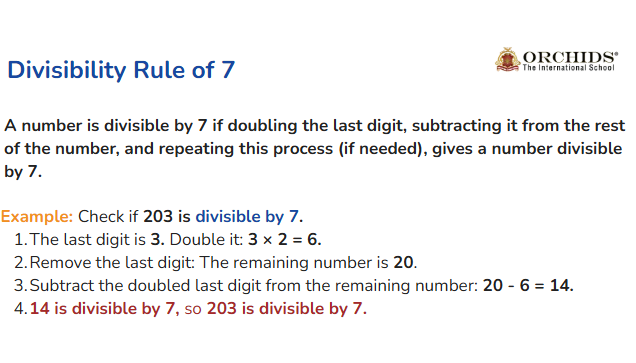Divisibility Rule of 7: Rule, Examples
Divisibility Rule of 7
A number is divisible by 7 if, when we double the last digit and subtract it from the rest of the number, the result is a multiple of 7 (like 0, 7, 14, 21, etc.).
If the new number is still big, we can repeat the steps until we get a small number we can check easily.

Steps to Check Divisibility by 7
-
Take the last digit of the number.
-
Double it. (Multiply it by 2)
-
Subtract this number from the rest of the number.
-
If the result is a multiple of 7 or becomes 0, then the number is divisible by 7
Examples
Example 1: Is 203 divisible by 7?
-
Take the last digit: 3
-
Double it: 3 × 2 = 6
-
Subtract from the rest of the number: 20 - 6 = 14
-
14 is a multiple of 7 (14 ÷ 7 = 2)
203 is divisible by 7.
Example 2: Is 364 divisible by 7?
-
Take the last digit: 4
-
Double it: 4 × 2 = 8
-
Subtract from the rest of the number: 36 - 8 = 28
-
28 is a multiple of 7 (28 ÷ 7 = 4)
364 is divisible by 7.
Know the divisibility rule of 8 here.
Try It Yourself:
Are they divisible by 7?
1. 574
2. 133
3. 945
FAQs
-
What is the divisibility rule of 7 with example?
The divisibility rule for 7 involves taking the last digit of a number, doubling it, and subtracting that result from the remaining portion of the number. If the difference is divisible by 7 (or is 0), then the original number is also divisible by 7.
-
Is 458409 divisible by 7?
As a result, (1* 2 = 2) Subtract 2 from the remaining number, which equals 44. As a result, 44 – 2 = 42. The number 42 is the sixth multiple of 7. As a result, we know that 458409 is divisible by 7.
-
What is an example of divided by 7?
There are 14 numbers between 1 and 100 that can be divided by 7 precisely. 7, 14, 21, 28, 35, 42, 49, 56, 63, 70, 77, 84, 91 and 98 are the numbers.
CBSE Schools In Popular Cities
- CBSE Schools in Bangalore
- CBSE Schools in Mumbai
- CBSE Schools in Pune
- CBSE Schools in Hyderabad
- CBSE Schools in Chennai
- CBSE Schools in Gurgaon
- CBSE Schools in Kolkata
- CBSE Schools in Indore
- CBSE Schools in Sonipat
- CBSE Schools in Delhi
- CBSE Schools in Rohtak
- CBSE Schools in Bhopal
- CBSE Schools in Aurangabad
- CBSE Schools in Jabalpur
- CBSE Schools in Jaipur
- CBSE Schools in Jodhpur
- CBSE Schools in Nagpur
- CBSE Schools in Ahmednagar
- CBSE School In Tumkur











